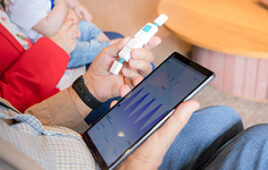Boehringer Ingelheim Pharmaceuticals, Inc. and Eli Lilly and Company announced Phase 3 study results for linagliptin 5 mg once-daily, which showed significant hemoglobin A1c (HbA1c or A1C) reduction of 0.88% compared to 0.24% in the placebo group (p=0.0002) at 24 weeks in black or African American adult patients with type 2 diabetes whose blood sugar was not adequately controlled. Linagliptin is marketed as Tradjenta 5 mg once-daily tablets in the U.S., and is the first and only member of the dipeptidyl peptidase-4 (DPP-4) inhibitor class to be approved at one dosage strength. The data were presented at the American Association of Clinical Endocrinologists (AACE) 21st annual Scientific and Clinical Congress.
Tradjenta is indicated as an adjunct to diet and exercise to improve glycemic control in adults with type 2 diabetes mellitus. Tradjenta is a DPP-4 inhibitor that does not require dose adjustments regardless of declining renal function or hepatic impairment. Tradjenta should not be used in patients with type 1 diabetes or for the treatment of diabetic ketoacidosis (increased ketones in the blood or urine). It has not been studied in combination with insulin.
In the U.S., African Americans and other ethnic minorities are significantly underrepresented in clinical trials. This is the first published trial of a DPP-4 inhibitor specifically conducted in black or African American adult patients with type 2 diabetes.
“These findings support the efficacy and safety profile of linagliptin as a treatment option for African American adult patients with type 2 diabetes,” said lead investigator James Thrasher, MD, FACE, Arkansas Diabetes and Endocrinology Center. “As there may be differences in response to treatment among ethnic groups, an important finding of this trial is that the results are consistent with the A1C reduction seen in the linagliptin pivotal trials, which included a small sample of African American patients.”
African American adults are disproportionately affected by diagnosed diabetes. In the U.S., the risk of diabetes is 77% greater for non-Hispanic black adults, when compared to non-Hispanic white adults, with an estimated 18.7% (4.9 million) of all non-Hispanic black adults living with the disease.
In the 24-week study, 226 patients were randomized (106 to linagliptin, and 120 to placebo), and received at least one dose of the study drug in order to be included in the safety analyses. Patients who had a measurement of A1C at baseline (linagliptin 8.63% +/-0.11; placebo 8.70% +/-0.11) and at least one measurement post-baseline (200) were included in the analyses of efficacy. A1C was measured every six weeks during the study and the difference between the groups was significantly different by six weeks and remained so throughout the study.
The number of patients experiencing adverse events was similar for the linagliptin and placebo groups. The most common adverse events reported in this trial were hyperglycemia (high blood sugar levels [linagliptin 2.8%; placebo 9.2%]) and nasopharyngitis (inflammation of the nose or pharynx [linagliptin 3.8%; placebo 5%]). Hypoglycemia occurred in three patients in the linagliptin group and one patient in the placebo group, and none of the events required external assistance.
“These data are important because we know that African Americans are significantly more likely to have diabetes than non-Hispanic Whites,” said John Smith, MD, PhD, senior vice president for clinical development and medical affairs, Boehringer Ingelheim Pharmaceuticals, Inc. “This study suggests that linagliptin provides black or African American adult patients with another option to improve control of their blood sugar, and it also reaffirms Boehringer Ingelheim and Lilly Diabetes’ shared commitment to address the needs of the millions of Americans living with type 2 diabetes.”
A secondary endpoint of the study looked at the proportion of patients with an A1C value of less than 7.0%, a target level recommended by the American Diabetes Association. Although the study was designed to recruit patients with an A1C of at least 7.5% at screening, a few patients were below 7.0% at the baseline measurement, and these patients were excluded from this analysis. All other patients with a baseline and at least one on-treatment measurement were included. At week 24, patients in the linagliptin group were significantly more likely to meet this target (28.0% versus 8.7%, p=0.001).
Patients in the linagliptin group were also significantly more likely to see an A1C reduction of at least half a percent at week 24, with more than half the patients (55.3%) in the linagliptin group having a reduction of 0.5% or more, compared with 28.3% in the placebo group (p < 0.0001).
Date: May 25, 2012
Source: Eli Lilly and Company




